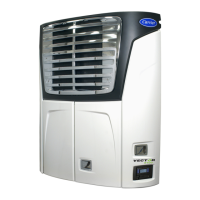7–67 62-11785
05007 BAD F3 FUSE
• ACTIVATION: Stepper Board Fuse Alarm; Feedback from Stepper Board indicates fuse is missing or
blown. Signal must be present for at least 3 seconds.
• UNIT CONTROL: Alarm only.
• RESET CONDITION: Replace or fix fuse issue.
NOTE: Follow the steps below until a problem is found. Once a repair or correction has been made, clear the
alarm(s). (See Note 1 in Notes Section.) Operate the unit through the appropriate modes to see if any active
alarm occurs. Continue with the steps below as necessary.
CORRECTIVE ACTIONS:
Check Fuse F3
a. Visually check fuse. Verify correct fuse, and check fuse holder for damage, see Figure 2.4.
Replace fuse as required. Clear alarms, restart and check for repeat alarm(s).
b. Check voltage. Check voltage through the fuse, if fuse is blown, replace it.
c. Check wiring from PCM34 - SP-18 - 2SVM22. Verify there is no physical damage to harness, and
no damage, moisture, or corrosion in connectors.
05008 BAD F10 FUSE
• ACTIVATION: Output Board Fuse Alarm; Feedback from Output Board indicates fuse is missing or blown.
Signal must be present for at least 3 seconds.
• UNIT CONTROL: Shutdown and Alarm.
• RESET CONDITION: Replace or fix fuse issue.
NOTE: Follow the steps below until a problem is found. Once a repair or correction has been made, clear the
alarm(s). (See Note 1 in Notes Section.) Operate the unit through the appropriate modes to see if any active
alarm occurs. Continue with the steps below as necessary.
CORRECTIVE ACTIONS:
1. Check Fuse F10
a. Visually check fuse. Verify correct fuse, and check fuse holder for damage, see Figure 2.4.
Replace fuse as required. Clear alarms, restart and check for repeat alarm(s).
b. Check voltage. Check voltage through the fuse, if fuse is blown, replace it.
c. Check wiring from PCM8 - 3MM34 - PCM9 - 3MM23. Verify there is no physical damage to
harness, and no damage, moisture, or corrosion in connectors.
2. Check LIV
a. Visually verify there is no physical damage to harness, and no damage, moisture, or corrosion in
connectors.
b. Check for high amp draw. Refer to Section 2.10 for correct electrical values. Use ammeter.

